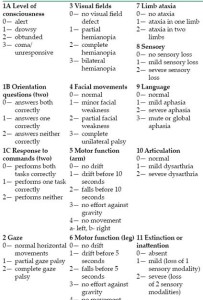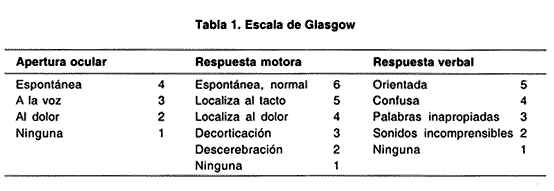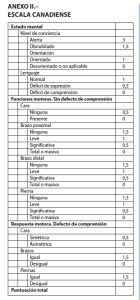The NIHSS (National Institute Health Stroke Scale): is best quantified and score neurological impairment after stroke.
It evaluate speach, visual field, strength, sensitivity of different limbs and cortical signs. Scoring 0 asymptomatic and summation of various items Score 19 to complete right ACM stroke and score 21 in left MCA (due to the increased number of items that scores speach). In vertebrobasilare infarctions despite their involvement can go with low scores.
A small limitation is interobserver variability that should be avoided by case reports test and certifications/recertify every two years. However items such as sensitivity-extinction, score of dysarthria in case of aphasia are those who can show some differences according to the score considers or judge by the explorardor or stroke team. To disminish this variability is important check neurological exam and score by all members of stroke team and review how several on-going trials explain the form to rate NIH in their appendix.
Press here to check NIHSS exam (Official training)⇐

GLASGOW COMA SCALE( GCS):
Its usefulness lies in the assessment and early detection of clinical worsening, the possibility to assess if mass effect bruising and the need to apply some treatment to reduce intracraneal pressure or need to protect airway and intubation. However it is not very useful to assess the degree of neurological impairment in conscious patient with extensive stroke, as it always rate best hemibody.

CANADIAN SCALE:
Like the NIHSS scale but more simple and fast in application, it allows frequent evaluation of patients with stroke in stroke units ( e/ 3h) and subsequently would be in the course of its evolution in order to detect clinical worsening or complications. It is ideal for use in stroke nursing care. A decrease of one point or more we warn of a possible neurological worsening. It has a good correlation with NIH score decay in case of clinical worsening situation.
Check other parts of www.hubstroke.com to learn more about stroke NEWS.
